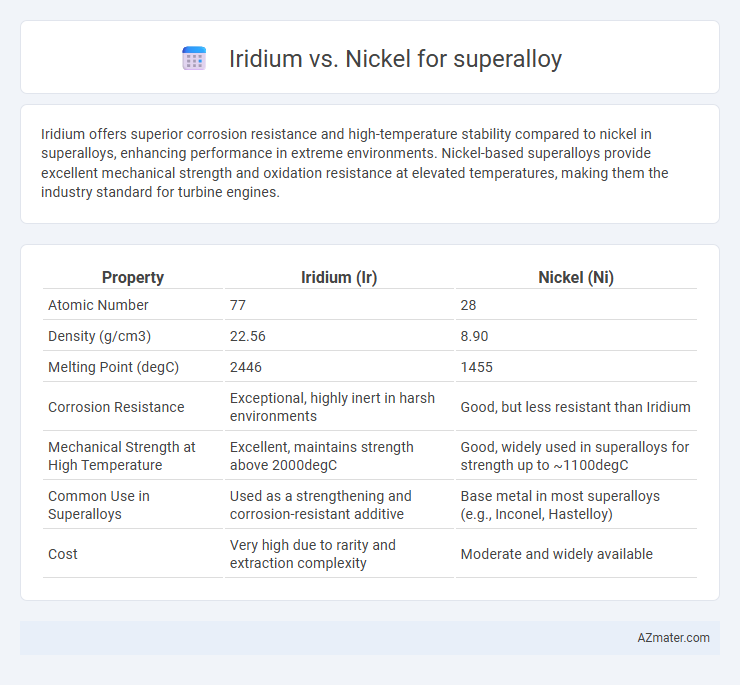Iridium offers superior corrosion resistance and high-temperature stability compared to nickel in superalloys, enhancing performance in extreme environments. Nickel-based superalloys provide excellent mechanical strength and oxidation resistance at elevated temperatures, making them the industry standard for turbine engines.
Table of Comparison
| Property | Iridium (Ir) | Nickel (Ni) |
|---|---|---|
| Atomic Number | 77 | 28 |
| Density (g/cm3) | 22.56 | 8.90 |
| Melting Point (degC) | 2446 | 1455 |
| Corrosion Resistance | Exceptional, highly inert in harsh environments | Good, but less resistant than Iridium |
| Mechanical Strength at High Temperature | Excellent, maintains strength above 2000degC | Good, widely used in superalloys for strength up to ~1100degC |
| Common Use in Superalloys | Used as a strengthening and corrosion-resistant additive | Base metal in most superalloys (e.g., Inconel, Hastelloy) |
| Cost | Very high due to rarity and extraction complexity | Moderate and widely available |
Introduction to Superalloys
Superalloys are advanced metal alloys designed to withstand extreme temperatures and mechanical stress, commonly used in aerospace and power generation. Iridium-based superalloys exhibit exceptional high-temperature strength and corrosion resistance, making them suitable for harsh environments. Nickel-based superalloys dominate the industry due to their excellent oxidation resistance, phase stability, and ability to maintain mechanical properties at temperatures up to 1100degC.
Importance of Alloying Elements in Superalloys
Iridium and nickel play crucial roles as alloying elements in superalloys, with nickel serving as the primary matrix metal due to its excellent high-temperature strength and corrosion resistance. Iridium, though less abundant, enhances grain boundary strength and oxidation resistance, significantly improving the superalloy's performance in extreme environments such as aerospace engines. Optimizing the balance between iridium and nickel content tailors mechanical properties and thermal stability, essential for advancing superalloy technology.
Overview of Iridium and Nickel
Iridium, a dense, corrosion-resistant platinum-group metal, excels in high-temperature and oxidative environments, making it valuable for superalloy applications requiring exceptional stability. Nickel, a base metal widely used in superalloys, offers excellent toughness, corrosion resistance, and high-temperature strength, serving as the primary matrix element in most superalloys. The contrast between iridium's superior oxidation resistance and nickel's versatile alloying capabilities defines their distinct roles in advanced superalloy development.
Chemical and Physical Properties Comparison
Iridium exhibits exceptional corrosion resistance and a melting point of 2446degC, making it highly stable in extreme environments compared to nickel, which melts at 1455degC and is less resistant to oxidation. Iridium's higher density (22.56 g/cm3) and hardness contribute to superior wear resistance, while nickel offers better ductility and thermal conductivity. These chemical and physical properties influence their selection in superalloys, with iridium favored for high-temperature, high-stress applications and nickel preferred for its balance of strength and formability.
High-Temperature Performance: Iridium vs. Nickel
Iridium exhibits superior high-temperature performance compared to nickel due to its exceptional melting point of 2446degC and excellent oxidation resistance, making it ideal for extreme environments in superalloy applications. Nickel-based superalloys typically perform well up to around 1000degC but degrade at higher temperatures due to oxidation and creep, limiting their use in ultra-high-temperature scenarios. Iridium's stability and strength at elevated temperatures provide crucial advantages for aerospace and industrial turbines requiring enhanced durability and corrosion resistance.
Corrosion and Oxidation Resistance
Iridium exhibits superior corrosion and oxidation resistance compared to nickel when used in superalloys, maintaining structural integrity at extremely high temperatures and harsh environments. Nickel-based superalloys provide good corrosion resistance, but iridium's exceptional stability in oxidative atmospheres enhances longevity and performance in aerospace and chemical processing applications. Iridium superalloys resist sulfidation and scaling better than nickel superalloys, making them ideal for components exposed to aggressive oxidative conditions.
Mechanical Strength and Durability
Iridium exhibits superior mechanical strength and exceptional durability at high temperatures, making it ideal for superalloy applications subjected to extreme environments. Nickel-based superalloys offer excellent strength and corrosion resistance while maintaining good ductility and toughness, especially under cyclic loading conditions. The choice between iridium and nickel depends on specific performance requirements, with iridium favored for ultra-high temperature stability and nickel preferred for overall balanced mechanical properties in high-stress aerospace and industrial components.
Cost and Material Availability
Iridium's high cost and scarce availability limit its use in superalloys despite excellent corrosion resistance and high melting point. Nickel is more abundant and significantly cheaper, making it the preferred choice for superalloy bases in aerospace and industrial applications. Cost-efficiency and material accessibility position nickel alloys as dominant in large-scale production compared to iridium-based alternatives.
Industrial Applications of Iridium and Nickel Superalloys
Iridium superalloys excel in high-temperature corrosion resistance and oxidation stability, making them ideal for aerospace components and catalytic converters in harsh environments. Nickel superalloys dominate turbine blades, jet engines, and nuclear reactors due to their exceptional strength, thermal stability, and fatigue resistance at elevated temperatures. Industries prioritize nickel superalloys for mass production and structural applications, while iridium alloys are reserved for specialized uses requiring unmatched chemical inertness and durability.
Future Trends in Superalloy Development
Iridium and nickel play crucial roles in advancing superalloy performance, with iridium offering exceptional high-temperature stability and corrosion resistance, crucial for aerospace and energy applications. Nickel-based superalloys dominate the market due to their excellent mechanical strength and oxidation resistance at elevated temperatures, but future trends emphasize enhancing these alloys with iridium additions to improve creep resistance and thermal stability. Research focuses on nano-scale alloying techniques and additive manufacturing to optimize the synergy between iridium and nickel, driving the next generation of superalloys for extreme environment applications.

Infographic: Iridium vs Nickel for Superalloy
 azmater.com
azmater.com